Originally Posted by
petit plateau
Let us assume for a moment that Boeing have truly dropped the ball re the 737 refreshes, and the 737 replacement product, vs the A320 family refreshes from Airbus. Let us assume that one is either a very senior person at Boeing (or their bondholders) or in the potential sources of competing product (Embraer, Comac, GD, Silly Valley .... Austin, etc) or their major stakeholders in Beijing, Sao Paulo, etc, and of course the engine companies and their associated nation-state golden share holders (or equivalents).
If so - then it is worth reading the latest entries in the (mis-named) EVTOL thread. Specifically they are regarding a Delft/etc conceptual design for a 76 tonne (76,000 kg) x 90-seat propellor driven BEV aircraft with a 1,000 km (LHR-ATH) range and a 2030s launch date possibility that would take about 1/3 of the potential marke (19% - 52% depending on how you count, see Fig 10 in the Delft study).
EVTOL news and progress - do we need a new dedicated section?
https://pure.tudelft.nl/ws/portalfil..._90_seater.pdf
There are also related discussion going on regarding the commercial viability and the volume scalability of the drop-in liquids eSAF and bioSAF on the one hand; the growth of high speed rail networks on the other hand; the unlikelihood of a hydrogen future; and the rapid growth in all things virtual and bandwidth/latency-related including whatever is called telepresence, virtual worlds, or whatever on any given day of the week.
So .... against this background, how would any potential new entrant manage the market entry risk associated with a fossil-fuel-powered narrowbody jet when there is one perfectly decent one available (A320-series) and two that are in various forms passable (737 and 919) if one is prepared to accept other 'issues'. Assuming one was technically successful in negotiating the project risks in bringing a cleansheet A320-series competitor to market in (say) the early 2030s, then how would one lock-in commercial success early enough so as to guarantee a good economic result by (say) mid-2030s when all the other pressures might completely restructure the market in favour of entirely different solutions.
These are the issues that any serious board looking at such a concept will likely be grappling with. Taking on the high risks of being just a 'me-too' new entrant as a A320-peer are one thing. Doing so just at the same time as high-bypass turbofans get supplanted by entirely different thrust devices with entirely different energy sources; or when the demand for travel goes through some major qualitative and quantitative shift entirely; is an entirely different class of risk.
I accept that for some types of competitor (i.e. nation-states) these may be acceptable risks for reasons of access to other value streams. But for mere commercial entities I suggest this is not a good reason to step forwards unless one is holding a gold-plated cost-plus contract.
Tell me, at what energy density does a 2,000-km range become attractive. If you can tell me that, I can tell you how many years wide your window of opportunity is to launch a commercially-funded conventional fossil-driven high-bypass ratio turbofan medium-range single-aisle*. Then you can judge whether you feel lucky.
(* my guess is a 5-10 year window, no more, until 1,000-1,200 Wh/kg cell densities are available, i.e. mid-to-late 2030s, almost certainly by 2040)
In the 1950-2020 period lots of stuff happened in jet airliners and the associated travel industry, but the main technologies increasingly focussed onto high-bypass. Now is a moment when that design paradigm may no longer hold true. It takes a brave business to launch a new 'conventional' product into such a market.
Petit P; whatever the source of conversion from a fuel to an output to achieve some work, in the end y'all gotta convert that output from the engine to a means to develop a useful force.
Nootin' gave us a heads up with his Rule #3, where push meets shove, and that is how every current means of propulsion works, whether it is a Saturn V, Cessna 150, or arguably even your drive tyres on your bicycle. For aircraft, we have simple matters, f=m.an and that is restated as mdot.V. Whether it is an afterburner, turbojet, turbofan or propeller, force is generated by pushing a mass out the back, at a velocity greater than free stream. That bit ain't going away anytime soon. A core massflow happens to be hot, so the local speed of sound is higher, that helps avoid massflow choking at Mach 1.0. A fan massflow is a lower velocity, but higher mass flow, and it gives a better propulsion efficiency from less V losses in the far field. Unfortunately, the faster you fly, the lower the fan thrust component for the engine, for two simple reasons....
1. The fan is effectively a fancy fixed pitch prop. It is limited in the blade angle that can be set for takeoff, static, as stall has to be avoided, (blades are susceptible to flutter, and there is a lot of uglies that occur around non axisymmetric flow into the engine... Those mid span shrouds... dampers... they are there as they need to be normally. The fan blade actually is subject to torsion-bending that is pretty neat, as it is a splined section, the resultant aero forces cause torsion not just bending, and that happens to torsion to higher blade angles. All good when steady case, and when your blades don't have stress concentration built in as a design "feature".
2. The gross thrust output is great at relatively low speeds, but at cruise speed, all that TAS is working against your fan thrust output. For my turbofan in flight test, static 54% of the thrust is derived from the fan normally at sea level, but at FL400, M080, that is below 25%. (thats standard... my engine does something rather different).
FN Gross:
[img]blob:https://www.pprune.org/5dd94502-aa50-4e4b-9c8a-6e0b375059bb[/img]
FN Net:[img]blob:https://www.pprune.org/b5b6caa7-8846-4a29-bfa6-a6debfff1ff0[/img]
Thrust "Drag" Losses:
[img]blob:https://www.pprune.org/7e9873db-f15e-4fcf-826a-c2809567ad5a[/img]
Way back when, Mr Froude n' Co sorted out ways to explain how a propeller works, by the means of an actuator disc, and that is a nice and simple analysis so long as you aren't running into compressibility, which unfortunately almost every prop on the planet does in use. (Keeping the tip velocity subsonic with respect to relative airflow is one thing, but if the blades have any level of resultant force giving a thrust component will be transonic, accelerating flow on the suction face to greater than Mach 1, and generating shocks (gaining entropy, sucks), mussing up the boundary layer, and the "CL's" and the "CD's" and the "Cm's". Your vibration isn't all from the engine, much of it is from the unsteady aero effects on the propeller. Prandtl added blade element theory to the propeller understanding, and yet, it is still just achieving Nootin's 3rd law, just as the the turbojet and the turbofan do.
The higher bypass achieves better propulsive efficiency, to a point. As the area of the intake gets bigger, so does the drag from the nacelle. Somewhere a bit past the GE90, we are about at the end of the diameter game for the engine, and can only improve stuff by gearing or variable blade angles or doing some magic.
For anyone who looks at the spoilers below, this causes some curious outcomes in the equations for turbomachinery.
1. Yes, we have removed a specific fluid mechanics limitation that exists in turbomachinery, and it was done by some neat aerodynamics.
2. Yes, the equations of propulsion efficiency look odd, I can't help that, I can only go by what the plane does, and it suggests that we are already overstating propulsive efficiency a tad. Anyone who likes algebra, we have a group of people working on resolving the surprise of propulsive efficiency.
3. No, we do not alter thermodyamics of the core of the blender at all. We do however alter profoundly the entropy of the fan, and the mass flow and velocity of the bypass flow. Amazingly, the engine core doesn't know that it is being fooled, the only difference is that at low RPM, fuel flow is slightly higher, but within error margins, and at higher RPM, fuel flow is around 1% lower than standard for a given RPM, with EGT following suit.
4. It has been flown to FL450, M080 so far, and seems happy enough to go to STC.
5. Vibration is lower, and loads on the fan blades and disc are lower than standard. That is a necessary outcome of the aerodynamics, and has been observed on propellers, helicopter rotors and turbo fans.
What magic looks like....

Engine Test Cell run, for control engine.
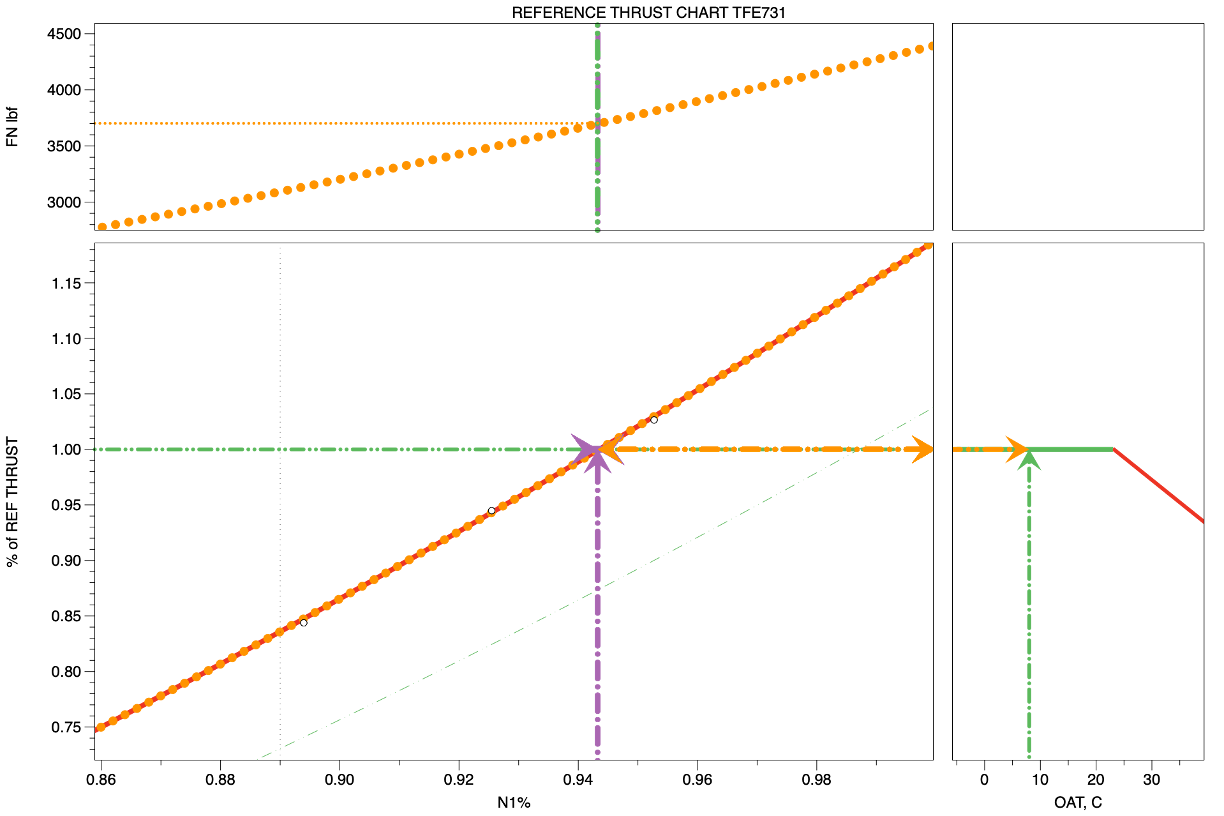
Test cell corrected data.
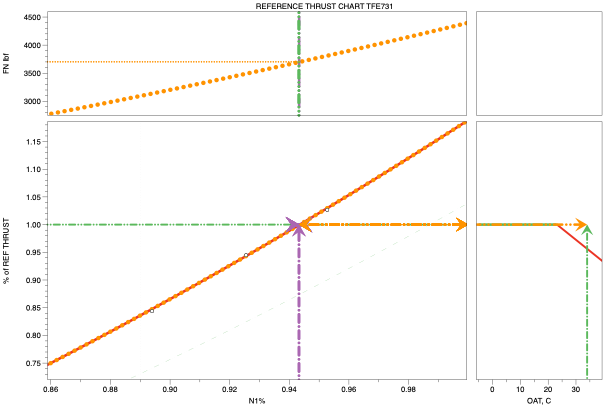
Test case OAT entry, (+34C)
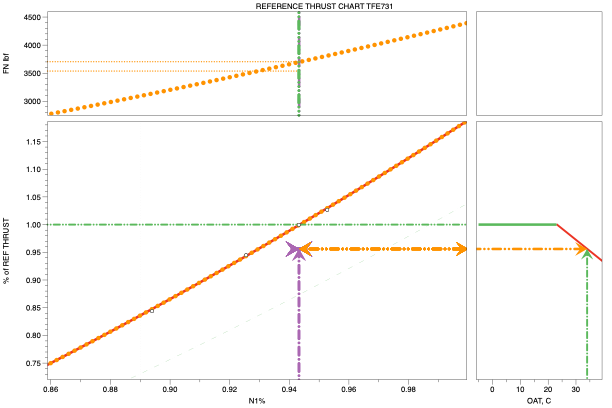
Correcting the limit % Thrust available for the OAT above critical temperature.
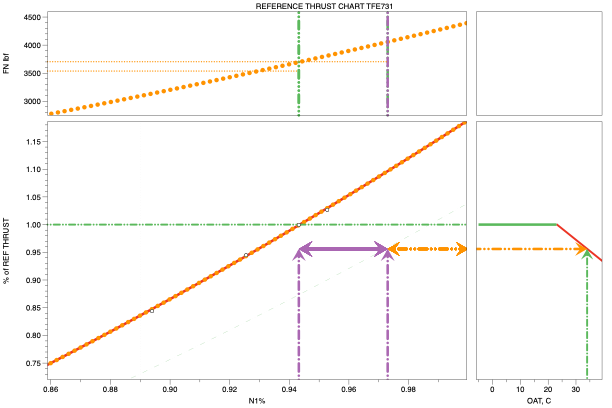
Entering the target N1% to achieve rated thrust % for the OAT.
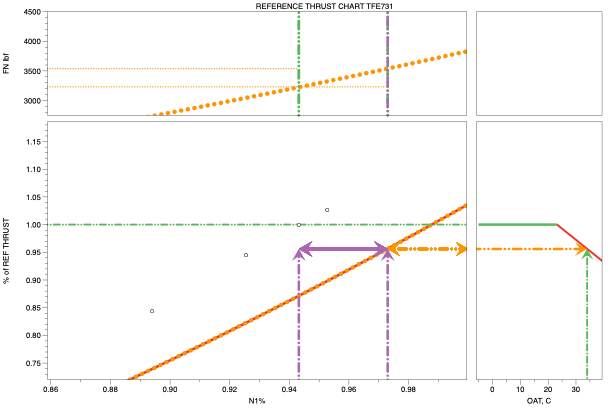
Adjusting Thrust/N1 curve to align with limit targets.

Runway symmetry runs... open control loop, set control thrust and expected N1 for the test engine.... Gets there in about 3 runs... +/-, without losing too much hair. (wide runways are nice) If setting equal N1 for control and test case, note the runway ends up looking short and really wide. avoid grass stains.
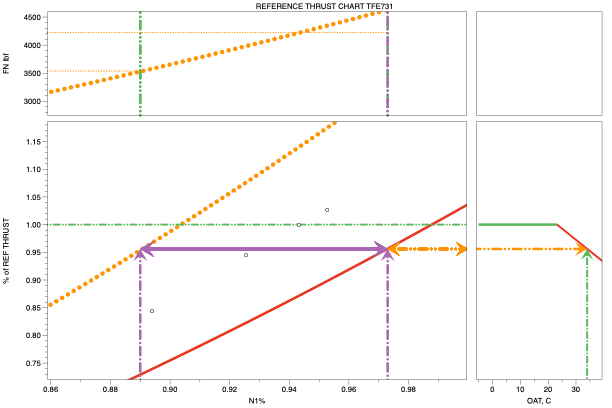
Adjust factor for test thrust curve, to intercept the N1 observed for symmetric thrust, and the % thrust line.
After this lot, go fly, and check changes for cruise case.
Note: the above case is per a recorded test, and in fact was not quite equal, the test case @ 89% N1 was producing more thrust than the control engine @ 97.5%, equal thrust was achieved at 87% N1 test vs 97.5% control.
Why use the example of the video? The RHS is occupied by an SME from the OEM of the engine, so it was independent of our fingerprints, for better or worse.
However, who wants more thrust? Apart from the A10 drivers, and the Buff, the main thing is efficiency, and that comes only if the TSFC is better. The biggest issue we have with getting more efficiency is that we get more thrust for the same N1, so for some aircraft, that becomes an interesting little factor to deal with. The take off case we are able to get about 40% more thrust out of the engine at Go Around N1, so thats fun for my plane, but many of the planes that are out there, we don't want to be giving the crew more thrust in the G/A, it is a busy enough time already without adding the equivalent of an afterburner to the equation.
[img]blob:https://www.pprune.org/918ab866-45e5-477c-8917-8529bea6df18[/img]
So... for the figures above, the engine happens to run 1% lower fuel flow for equal N1's, and about 20C lower EGT.... for equal thrust case, there is a big difference.
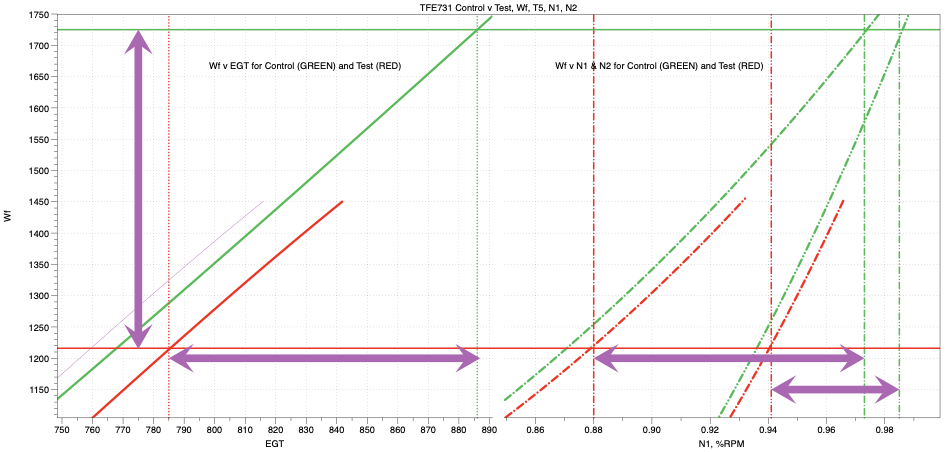
Magic at FL400, M076
So, doing something at sea level is one thing, but the planes need to work for a living...
At FL400, setting the test engine to the N1 for M0695, and the control engine N1 for M073, one would assume that an outcome would be about 1/2 of the difference between the two thrust settings... say, M0713 or so. The plane settles down at M0760. Doesn't sound like much, but, all of the change has happened from the test engine... and so that is a fair change in thrust.
Going from M0695 to M0760 is 760/695 as a change in speed, V, and the energy needed to do that is the square of the speed difference, V^2. So, the test engine gives (760/695)^2 more thrust, net, AND, it is also dragging the control engine from M0730 to M0760, which is.... (760/730)^2.
(760/695)^2 = 1.094^2 = 1.196
(760/730)^2 = 1.041^2 = 1.084
= 1.135^2 = 1.280
So, for modifying one engine, and running it at an RPM and fuel flow and EGT consistent with M0695, we are actually getting 28% more thrust in the cruise. That is for ONE of TWO engines. For both engines, the plane goes quite well.
This test done at FL400, M0760 is above the FPPM performance limit conditions.... by about 5,000' for that Mach number.
We are in the STC phase of this, with only two small airlines that are working with us as a JV partner for the first STC's. Thats OK, the rest of the airlines will be paying a fee that will make up for the lack of interest they have in CO2 reduction.
This modification is a field modification; My engineers modify a 30 blade turbofan in an hour. Propellers are faster to do, about 20 minutes for a C-130/L100-30 54H60 prop.
My work doesn't break physics, it is actually pretty elegant physics,
The prop is less effective, the turbofan is quite neat.
We are open to investment at the moment, but only at private placement, or investment groups, or HNW's. Investment is to redeemable preference shares, with a fixed redemption price. The shareholders can defer redemption for a period post revenue, their shares do accrue dividends at an agreed rate.